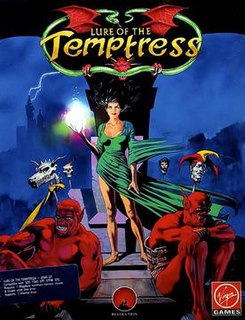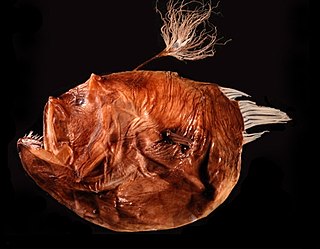
Trolling is a method of fishing where one or more fishing lines, baited with lures or bait fish, are drawn through the water. This may be behind a moving boat, or by slowly winding the line in when fishing from a static position, or even sweeping the line from side-to-side, e.g. when fishing from a jetty. Trolling is used to catch pelagic fish such as salmon, mackerel and kingfish.

A fishing rod is a long, thin rod used by anglers to catch fish by manipulating a line ending in a hook. At its most basic form, a fishing rod is a straight rigid stick/pole with a line attached to one end ; however, modern rods are usually elastic and generally have the line stored in a reel mounted at the rod handle, which is hand-cranked and controls the line retrieval, as well as numerous line-restricting rings that distribute bending stress along the rod and help dampening down/prevent line whipping and entanglement. To better entice fish, baits or lures are dressed onto the one or more hooks attached to the line, and a bite indicator is used, some of which might be incorporated as part of the rod itself.

A ghoul is a demon-like being or monstrous humanoid. The concept originated in pre-Islamic Arabian religion, associated with graveyards and the consumption of human flesh. Modern fiction often uses the term to label a certain kind of undead monster.

Angling is a fishing technique that uses a fish hook or "angle" attached to a fishing line to tether individual fish in the mouth. The fishing line is usually manipulated via a fishing rod, although rodless techniques such as handlining and longlining also exist. Modern angling rods are usually fitted with a reel that functions as a cranking device for storing, retrieving and releasing out the line, although Tenkara fishing and cane pole fishing are two rod-angling methods that do not use any reel. The hook itself can be additionally weighted with a dense tackle called a sinker, and is typically dressed with an appetizing bait to attract the fish and enticing it into swallowing the hook, but sometimes an inedible fake bait with multiple attached hooks is used instead of a single hook with edible bait. A bite indicator, such as a float or a quiver tip, is often used to relay underwater status of the hook to the surface.
The Heartbreakers, sometimes referred to as Johnny Thunders' Heartbreakers, were an American punk rock band formed in New York City in 1975. The band spearheaded the first wave of punk rock.

A fishing lure is a broad type of artificial fishing baits used in angling that are designed to mimic prey animal and attract the attention of predatory fish, using appearances, movements, vibrations, bright reflections and flashy colors to appeal to the fish's predation instinct and entice it into striking.

Lure of the Temptress is a point-and-click adventure game published by Virgin Interactive Entertainment in June 1992 for Atari ST, MS-DOS, and Amiga. It was the first game developed by Revolution Software and uses their proprietary Virtual Theatre engine. The player assumes the role of Diermot, a young peasant who has to overthrow an evil sorceress. The game was well-received and re-released as freeware on April 1, 2003.
A downrigger is a device used while fishing using the trolling method, which places a lure at the desired depth. A downrigger consists of a three to six-foot horizontal pole which supports a cannonball, generally 10 to 15 pounds, by a steel cable. A clip, also known as a "release," attaches a fishing line to the cannonball weight. The bait or lure is attached to the release.

A topwater fishing lure or walker is a type of surface fishing lure, usually floating just at the water surface, that may be moved about the surface of water in order to attract and cause fish to attempt to strike the lure. Non-floating versions may be retrieved at sufficient speed to cause them to travel at the water's surface.

Soft plastic bait, commonly known as soft lure, soft plastics, plastic bait, worm lure or just worm, is any of a range of elastomer-based fishing lures termed so because of their flexible, flesh-like texture. Soft lures are available in a large range of colours, sizes and particularly shapes, and are typically impaled directly onto a fishing hook like an ordinary bait.

A surface lure or topwater lure is a class of fishing lure that is designed to attract the attention of predatory fish through commotion produced at the water surface, imitating preys of interest swimming at the surface such as injured baitfish, frogs, wading mice, lizards and snakes, drowning insects and dabbling ducklings. These lures are preferred by some anglers due to the belief that they attract larger-than-average fish, and from the added excitement of actually seeing the sudden splashes created by fish aggressively breaching the surface to strike the lure.

The Original Floater is a wobbler type of fishing lure, manufactured by Rapala. It is modeled after the first lure created by founder Lauri Rapala, in Finland in 1936. That prototype was made of cork wrapped in tinfoil and covered in melted film negatives as a cheap alternative to lacquer.
Fishing rod tapers describe how much a fishing rod bends or flexes under pressure. Different tapers are used for different fishing scenarios as well as for personal preference.

Spin fishing is an angling technique where a spinnerbait, a type of hybrid fishing lure with at least one freely rotating blade, is used to entice the fish to bite. When the line is reeled back, the spinnerbait blades will spin passively with oncoming the water flow, in turn stirring up significant amount of turbulence and noise, which transmit through the water and provoke predatory fish to strike the lure out of their foraging as well as territorial instincts. Spin fishing is used in both freshwater and marine environments.
Grander Musashi, also known as Super Fisher Grander Musashi and Musashi the Great, is a Japanese manga series created by Takashi Teshirogi that was adapted into two anime seasons. It is a fishing sport anime that teaches audiences fishing methods. The target of this anime is usually families and children; it teaches them to appreciate nature and not destroy it. The main theme is protecting Mother Earth from being destroyed by technology and the greed of humans. It has influenced many audiences to fish for sport, as well as giving a good message to preserve nature. Grander Musashi is supported by the Fishing Club in Japan, and in the ending credits it shows a gallery of the bass fish they captured.
Swimbaits or swimmers are a loosely defined class of fishing lures that are designed to primarily imitate the underwater swimming motions of baitfishes.
The Deese–Roediger–McDermott (DRM) paradigm is a procedure in cognitive psychology used to study false memory in humans. The procedure was pioneered by James Deese in 1959, but it was not until Henry L. Roediger III and Kathleen McDermott extended the line of research in 1995 that the paradigm became popular. The procedure typically involves the oral presentation of a list of related words and then requires the subject to remember as many words from the list as possible. Typical results show that subjects recall a related but absent word, known as a 'lure', with the same frequency as other presented words. When asked about their experience after the test, about half of all participants report that they are sure that they remember hearing the lure, indicating a false memory – a memory for an event that never occurred.

Bufoceratias shaoi is a species of double angler, a type of anglerfish. The fish is bathypelagic and has been found at depths ranging from 0 to 1,200 metres. It has been found in the western Indian Ocean and western Pacific Ocean.
Bufoceratias thele is a species of double angler, a type of anglerfish. The fish is bathypelagic and has been found at depths ranging from 0 to 1,500 metres. It is endemic to the western Pacific Ocean.
Elwood "Buck" Lake Perry was the inventor of the form of fishing lure known as the spoonplug along with being an author.














